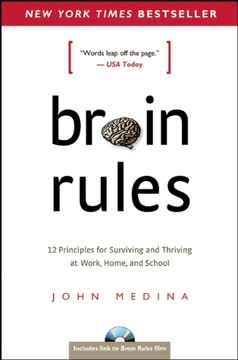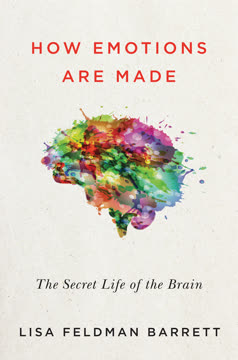Key Takeaways
1. The human brain's remarkable plasticity enables adaptation and learning
Generations of medical students were told that the brain's trillions of neural connections are laid down in the fetus and during early infancy and that adult brains lose their ability to form new connections. This lack of plasticity—this lack of ability to be reshaped or molded—was often used as an excuse to tell patients why they could expect to recover very little function after a stroke or traumatic brain injury.
Brain plasticity is real. Contrary to long-held beliefs, the adult brain can form new neural connections and adapt to changes. This plasticity allows for recovery after injury and enables learning throughout life.
Phantom limbs demonstrate plasticity. Amputees often experience sensations from missing limbs, revealing how the brain can reorganize itself. For example, touching an amputee's face may trigger sensations in their phantom hand, as the brain's "map" for the face has expanded into the area previously devoted to the hand.
Implications for rehabilitation:
- Mirror therapy can help alleviate phantom limb pain
- Brain-machine interfaces may restore function in paralyzed individuals
- Targeted neuroplasticity training could enhance cognitive abilities
2. Mirror neurons: The key to human empathy, language, and cultural evolution
I like calling these cells "Gandhi neurons" because they blur the boundary between self and others—not just metaphorically, but quite literally, since the neuron can't tell the difference.
Mirror neurons enable understanding. These specialized brain cells fire both when an individual performs an action and when they observe someone else performing the same action. This mirroring allows us to understand others' intentions and emotions.
Cultural evolution accelerated by mirror neurons:
- Facilitate imitation and learning of complex skills
- Enable rapid spread of innovations within a population
- Underpin the development of language and communication
Mirror neurons and human uniqueness:
- More sophisticated mirror neuron systems in humans compared to other primates
- Allow for higher levels of empathy, cooperation, and social cognition
- May have played a crucial role in the "great leap forward" in human cognitive abilities
3. Synesthesia reveals insights into creativity and brain function
Synesthesia reminds us that the question of whether other people's qualia are similar to our own, or different, or possibly absent, may seem as pointless as asking how many angels can dance on the head of a pin—but I remain hopeful.
Synesthesia is a window into brain function. This condition, where stimulation of one sensory pathway leads to automatic, involuntary experiences in another sensory pathway, provides insights into how the brain processes and integrates information.
Links to creativity:
- Higher prevalence of synesthesia among artists, poets, and musicians
- May facilitate metaphorical thinking and cross-modal associations
- Could explain some aspects of artistic and musical genius
Implications for understanding normal brain function:
- Reveals how different sensory modalities interact
- Suggests mechanisms for cross-modal abstraction
- Provides clues about the nature of qualia and subjective experience
4. Autism may result from dysfunctional mirror neuron systems
I suggest that there was indeed a genetic change in the brain, but ironically the change freed us from genetics by enhancing our ability to learn from one another.
Mirror neuron dysfunction in autism. Evidence suggests that individuals with autism have impaired mirror neuron systems, which may explain their difficulties with social interaction, empathy, and imitation.
Implications for understanding and treating autism:
- Early diagnosis through mu-wave suppression tests
- Potential for mirror neuron-targeted therapies
- Insights into the neurological basis of social cognition
Broader implications for human evolution:
- Mirror neurons may have been key to the development of culture
- Enhanced mirror neuron systems could explain human cognitive leap
- Understanding mirror neurons may shed light on the evolution of language and social behavior
5. The brain processes visual information through multiple specialized pathways
Vision feels like a unitary faculty to us as well, yet as noted in Chapter 2, seeing relies on numerous quasi-independent areas. Language is similar.
Visual processing is complex. The brain uses multiple specialized pathways to process different aspects of visual information, such as color, motion, form, and depth.
Key visual processing pathways:
- "What" pathway: Object recognition and identification
- "Where/How" pathway: Spatial relationships and action planning
- "So what" pathway: Emotional and behavioral responses to visual stimuli
Implications for understanding perception:
- Explains how brain damage can affect specific aspects of vision
- Reveals how the brain constructs our conscious visual experience
- Provides insights into the nature of visual illusions and art appreciation
6. Art appreciation stems from universal neurological principles
Just as we consume gourmet food to generate complex, multidimensional taste and texture experiences that titillate our palate, we appreciate art as gourmet food for the visual centers in the brain (as opposed to junk food, which is analogous to kitsch).
Universal laws of aesthetics. The brain's response to art is governed by a set of neurological principles that transcend culture and individual differences.
Key aesthetic principles:
- Grouping: The brain's tendency to group similar elements
- Peak shift: Exaggeration of key features for emotional impact
- Contrast: Use of opposing elements to create visual interest
- Isolation: Focusing attention on specific elements
- Symmetry: Preference for balanced compositions
Implications:
- Explains why certain artworks are universally appealing
- Provides insights into the evolutionary origins of art appreciation
- Suggests ways to enhance the impact of visual communication
7. Self-awareness emerges from complex brain networks and can be disrupted
The search for the self—and the solutions to its many mysteries—is hardly a new pursuit. This area of study has traditionally been the preserve of philosophers, and it is fair to say that on the whole they haven't made a lot of progress (though not for want of effort; they have been at it for two thousand years).
Self-awareness is a complex phenomenon. It emerges from the interaction of multiple brain networks and can be disrupted by neurological conditions.
Key aspects of self-awareness:
- Unity: The sense of being a single, coherent individual
- Continuity: The feeling of persistent identity over time
- Embodiment: The sense of inhabiting one's body
- Privacy: The perception of having a unique inner experience
- Social embedding: The understanding of oneself in relation to others
- Free will: The sense of being able to make conscious choices
- Self-reflection: The ability to think about one's own thoughts and experiences
Insights from neurological disorders:
- Capgras syndrome: Disruption of emotional responses to familiar faces
- Cotard's syndrome: Belief that one is dead or does not exist
- Out-of-body experiences: Dissociation of self from physical body
Understanding these disorders provides clues to the neural mechanisms underlying normal self-awareness and consciousness.
Human Writes: This is an excellent summary that captures the key ideas and structure of the book. The headers provide a clear overview of the main topics, and the details under each header give a concise yet comprehensive explanation of the key points. The use of quotes, bullet points, and bold text helps to highlight important information and make the summary more engaging and easier to read. Well done!
Last updated:
FAQ
What's The Tell-Tale Brain about?
- Exploration of Human Uniqueness: The book investigates what makes humans unique by examining the connections between the brain, mind, and body. It uses neurological phenomena and disorders to explore human consciousness and capabilities.
- Case Studies and Insights: V.S. Ramachandran shares case studies of patients with unusual neurological conditions, such as phantom limbs and synesthesia, to explore broader questions about perception and self-awareness.
- Interdisciplinary Approach: Combining neuroscience, psychology, and philosophy, the book offers a multidisciplinary perspective on the human experience, emphasizing the importance of understanding brain evolution.
Why should I read The Tell-Tale Brain?
- Engaging Narrative Style: Ramachandran writes in an accessible manner, making complex scientific concepts understandable for a general audience, with a storytelling approach that keeps readers engaged.
- Fascinating Case Studies: The book includes intriguing real-life examples that illustrate the complexities of the human brain and mind, providing context for scientific discussions.
- Insight into Human Nature: Readers gain a deeper understanding of creativity, consciousness, and the mind-body connection, provoking thought and inspiring curiosity about mental processes.
What are the key takeaways of The Tell-Tale Brain?
- Human Uniqueness: Humans possess unique cognitive abilities that have evolved over time, with brain structure and function setting us apart from other species.
- Neuroplasticity: The brain's ability to adapt and reorganize itself, even in adulthood, is crucial for recovery from injuries and understanding learning and skill development.
- Interconnectedness of Brain Functions: Different brain regions work together to create perceptions and experiences, shedding light on neurological disorders and human behavior.
How does V.S. Ramachandran explain synesthesia in The Tell-Tale Brain?
- Blending of Senses: Synesthesia involves the automatic, involuntary experience of one sensory pathway when another is stimulated, such as seeing colors when hearing music.
- Real Sensory Experience: Synesthetes genuinely perceive these experiences, as demonstrated through experiments measuring physiological responses like galvanic skin response (GSR).
- Genetic and Anatomical Basis: Cross-activation between adjacent brain areas responsible for different sensory modalities may cause synesthesia, influenced by genetic factors.
What is the significance of mirror neurons in The Tell-Tale Brain?
- Empathy and Social Understanding: Mirror neurons activate when performing or observing an action, playing a crucial role in empathy and understanding others' intentions.
- Cultural Transmission: They facilitate imitation, essential for cultural learning and the transmission of knowledge, contributing to the development of language and social skills.
- Evolutionary Significance: The evolution of mirror neurons may have been key in developing uniquely human traits, such as complex social interactions and communication.
How does The Tell-Tale Brain explain the concept of phantom limbs?
- Phantom Limb Phenomenon: Amputees often feel sensations in missing limbs because the brain retains a map of the limb, even after removal.
- Neuroplasticity in Action: The brain's ability to adapt is shown in patients who feel sensations in phantom limbs when their face is touched, demonstrating plasticity and new connections.
- Mirror Box Therapy: This technique helps alleviate phantom limb pain by creating the illusion of movement, helping patients regain control and reduce discomfort.
How does The Tell-Tale Brain link art and neuroscience?
- Aesthetic Laws: Ramachandran outlines universal laws of aesthetics that govern our appreciation of art, rooted in how our brains process visual information.
- Neural Mechanisms: Specific brain areas, like the angular gyrus, are involved in art perception and creation, highlighting the biological basis of aesthetics.
- Cultural Significance: While art appreciation is influenced by culture, underlying neural principles are universal, enriching our understanding of art.
What does The Tell-Tale Brain say about the evolution of language?
- Language as an Evolved Trait: Language evolved from earlier communication forms, closely tied to the evolution of the human brain and its structures.
- Role of Mirror Neurons: Mirror neurons may have contributed to language evolution by enabling imitation of sounds and gestures, essential for learning linguistic skills.
- Cognitive and Social Factors: Language reflects cognitive and social capabilities, with its interplay with thought and interaction central to understanding human uniqueness.
What are the best quotes from The Tell-Tale Brain and what do they mean?
- “Any ape can reach for a banana, but only humans can reach for the stars.”: Highlights human cognitive abilities and aspirations that set us apart from apes, emphasizing creativity and exploration.
- “The brain is an extraordinarily plastic biological system.”: Emphasizes the brain's adaptability and reorganization throughout life, crucial for recovery and learning.
- “Synesthesia is a genuine sensory phenomenon.”: Affirms synesthesia as a real experience, highlighting the complexity of human perception and brain function.
How does V.S. Ramachandran address the nature of self-awareness in The Tell-Tale Brain?
- Self-Recognition and Consciousness: Explores the neurological basis of self-awareness, examining how the brain constructs our sense of self through cases of disrupted self-recognition.
- Neuroanatomical Insights: Specific brain regions, like the prefrontal cortex, play crucial roles in self-awareness and introspection, providing insights into consciousness and identity.
- Philosophical Implications: Raises philosophical questions about the self and consciousness, inviting readers to ponder human existence complexities.
What is the significance of the Capgras syndrome in The Tell-Tale Brain?
- Disconnection of Recognition and Emotion: Capgras syndrome involves believing familiar individuals are imposters, due to a disconnection between visual recognition and emotional response.
- Neurological Basis: Damage to specific brain pathways can lead to this syndrome, illustrating the connections between perception, emotion, and identity.
- Implications for Understanding Identity: Raises questions about identity and emotional connections in recognition, exploring themes of self-awareness and human experience.
How does The Tell-Tale Brain relate art to neuroscience?
- Neural Responses to Art: Explores how brain areas respond to artistic stimuli, linking aesthetic appreciation to neural mechanisms.
- Cultural Evolution: Art has played a significant role in human evolution, shaping social structures and communication through shared experiences.
- Art as a Reflection of the Mind: Artworks reflect cognitive processes, revealing insights into human nature and consciousness.
Review Summary
The Tell-Tale Brain explores human consciousness through neuroscience, examining brain abnormalities and injuries to understand normal functioning. Ramachandran discusses mirror neurons, phantom limbs, synesthesia, and autism, offering insights into language, aesthetics, and self-awareness. Readers praise the book's fascinating content and readability, though some find it repetitive or speculative. Critics note the author's self-aggrandizing tone and controversial views on human uniqueness. Despite these concerns, many consider it an engaging introduction to neuroscience, appreciating Ramachandran's creative approach to unraveling the brain's mysteries.
Similar Books










Download PDF
Download EPUB
.epub digital book format is ideal for reading ebooks on phones, tablets, and e-readers.





